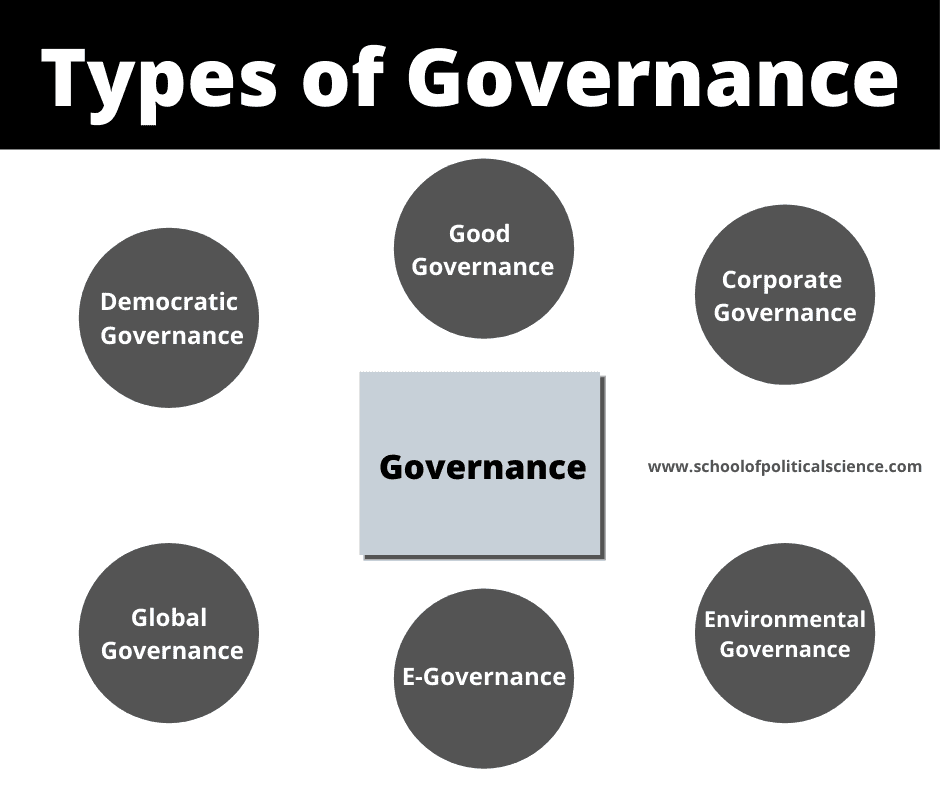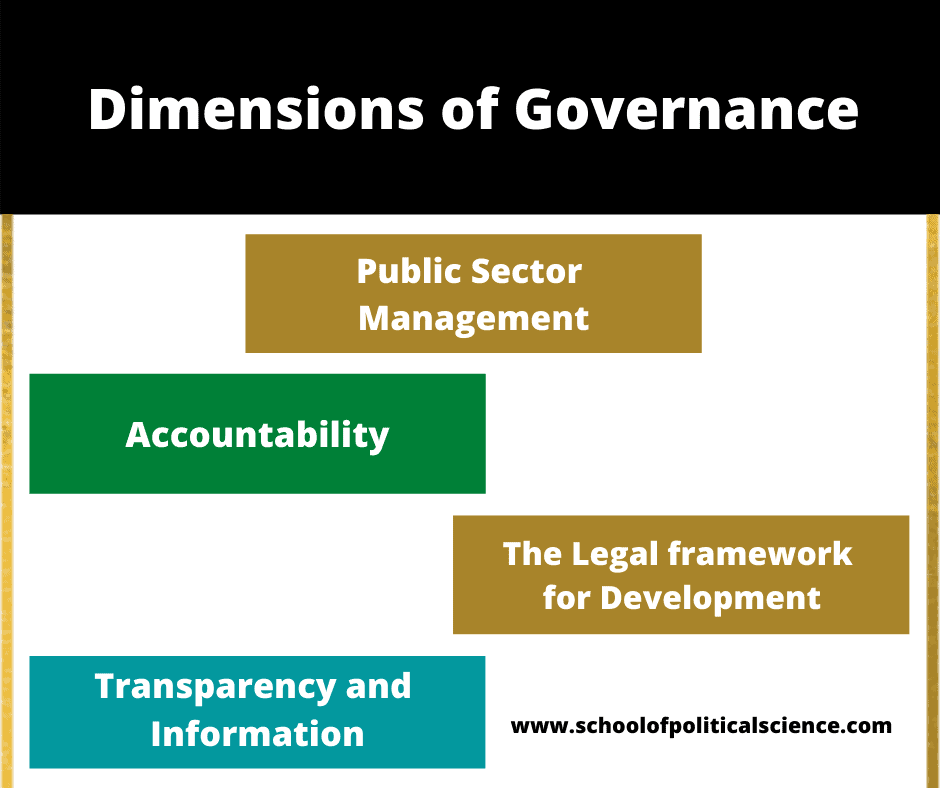Governance plays a crucial role in shaping societies, economies, and political systems across the globe. Understanding the various types of governance is essential for grasping how power is distributed, decisions are made, and resources are allocated.
Each governance structure comes with its unique characteristics, influencing the outcomes of policies and the lives of citizens. This article delves into the meaning of governance, explores its core dimensions, and provides an in-depth explanation of the 6 types of governance that drive the modern world. By the end, you’ll have a clearer understanding of how different governance models impact societies.
What does governance mean?
Governance refers to all aspects of the way the government fulfills its job for societal and economic development. It is a process of governing by which all governmental, as well as non-governmental organizations, civil societies, and private sectors, are involved in the process of policymaking and the process of implementation of those policies.
In simple words, The processes that lead policymaking and its implementation can be called governance.
Below, I have mentioned some definitions of governance that help you to understand governance from different angles.
Definitions of Governance
Governance can be defined as “the exercise of political authority and the use of institutional resources to manage problems and the affairs of the society”.
According to the World Bank’s document on “Governance and Development” (1992), governance is considered a process by which the legitimized power had been exercised for the utilization of resources of a country for development but not growth.
In 1989 the World Bank studied “Sub-Saharan Africa- from Crisis to Sustainable Growth”, referred to as governance as the need for institutional reform and a better and more efficient public sector. The main focus of the bank study was to analyze the developmental problems in sub-Saharan countries.
The bank emphasized the reformation of the public sector from the government to governance. During this period, the term governance was distinct from the government, and it was associated with civil society actors.
After the 1990s governance has become more important. During this time, public sectors have been reformed by the New Public Management’s aims e.g. economy, efficiency, and effectiveness through the principles of decentralization and de-bureaucratization.
Now It has been considered in terms of the utilization of socio-economic resources for ensuring effectiveness and efficiency in public services. The administrator has been considered as manager and the city has considered the consumer.
It has been also considered in terms of service delivery to the citizens. In other words, we can say that “governance involves decisions that define s expectations, grant power or verify performance”.
According to Rhodes “Governance refers to self-organizing, inter-organizational networks characterized by interdependence, resource-exchange, rules of the game, and significant autonomy from the state”.
To Hyden “Governance is the stewardship of the formal and informal political rules of the game. Governance refers to those measures that involve setting the rules for the exercise of power and settling conflict over such rules”.
From the above definitions, it can be concluded that governance is defined as the set of networks in the pursuit of common goals. These networks of governing processes can be intergovernmental or inter-organizational or can be transnational. It also can be defined in terms of the interaction between state and society.
Types of Governance

Governance varies based on the nature of an organization’s work. Different activities lead to different types of governance. Here are some common types.
- Participatory or Democratic Governance
- Global Governance
- Good Governance
- Corporate Governance
- Environmental Governance
- E-Governance
1. Participatory or Democratic Governance
Participatory or democratic governance allows citizens to take part in making and implementing policies. They can participate through elections, referendums, local meetings, protests, or self-governance.
Democratic governance is not just about rules and institutions; it is about how they work in a democratic way. Its main goal is to provide services to all parts of society. This can only happen when people actively take part in decision-making within democratic institutions.
2. Global Governance
Global governance is one of the most important types of governance. The term ‘Global Governance’ was first used by Rosenau. He explains that global governance includes systems of rule at all levels of human activity, from families to international organizations, where control and decision-making have effects across countries.
The idea of global governance comes from the fact that today, states exist alongside non-state actors. In addition to states, we have international institutions like the United Nations (UN), International Monetary Fund (IMF), World Bank, and World Trade Organization (WTO). There are also powerful non-state actors such as multinational corporations (MNCs), global civil society, and non-governmental organizations (NGOs).
This shows that governance today, especially from a global perspective, is a complex and debated concept. It also affects domestic policymaking, making governance within individual countries more contested and evolving.
3. Good Governance
Good governance is an ideal or normative concept that emerges when ethics and values are integrated into governance discussions. But what makes governance good governance?
Governance is considered good when it follows key principles such as participation, rule of law, transparency, responsiveness, consensus orientation, equity, inclusiveness, effectiveness, efficiency, and accountability. These elements ensure that governance serves the public fairly and efficiently, promoting trust and development in society.
Must Read- Good Governance: Definitions, Characteristics, And Importance
4. Corporate Governance
Corporate governance has become a widely discussed topic in boardrooms around the world. It refers to a set of rules and ethical guidelines that govern the corporate sector. Through corporate governance, governments can oversee and regulate corporate entities. To operate in a specific country or region, companies must comply with these established rules and standards.
Must Read- Corporate Governance: Meaning, Principles, And Importance
5. Environmental Governance
Environmental governance plays a crucial role in shaping international environmental regulations, advancing environmental science and information, and promoting sustainable development in alignment with national policies.
It focuses on managing the environment and natural resources efficiently to ensure their proper use while supporting long-term sustainability.
According to the United Nations Environment Programme (UNEP), “Environmental governance is a key driver for achieving sustainable development.” This can be accomplished through three key initiatives:
- Establishing coherent international decision-making processes.
- Strengthening legal and institutional frameworks to support national environmental priorities.
- Integrating environmental sustainability into development strategies at regional, sub-regional, and national levels.
6. E-Governance
The use of Information and Communication Technologies (ICT) in governance led to the concept of E-Governance. Also known as Electronic Governance, it is a modern approach aimed at making governance more transparent and accountable by using technology for the benefit of society.
E-Governance helps deliver services to citizens efficiently, reducing cost, effort, and time through internet-based solutions. It also strengthens the connection between the state and civil society and improves the functioning of public authorities at all levels of planning. Because of its focus on service delivery, it is often called a service-oriented concept.
E-Governance operates at four levels:
- G2C (Government to Citizens) – Services provided directly to the public.
- G2B (Government to Business) – Interaction between the government and businesses.
- G2G (Government to Government) – Communication and collaboration between different government bodies.
- G2E (Government to Employee) – Services and communication between the government and its employees.
Must-Read– E-Governance: Meaning, Objectives, Features, and 4 Types
Dimensions of Governance

According to the World Bank document ‘Governance and Development (1992), there are 4 key dimensions of governance. They are-
- Public Sector Management
- Accountability
- The Legal Framework for Development
- Transparency and Information
1. Public Sector Management
This dimension has been emphasized in the capacity building of the public sectors for a sound economy and quality service delivery to the citizens.
Within this dimension, three key areas have been focused on:
- Public expenditure management, Civil service reform, and parastatal reform for improving public investment programming and the budget process,
- Strengthening the personnel management and
- The effectiveness and efficiency of public services through the process of decentralization.
2. Accountability
This is one of the most important dimensions of governance. The World Bank very much emphasizes accountability. It has been described as ‘the heart of governance’. Generally, accountability means ‘holding public officials responsible for their action’. Political leaders have been responsible for the citizen for the implementation of sound socio-economic policies.
It has also been referred to as the balance between public policy and its implementation and proper allocation of public resources for social and economic development.
Public accountability depended on three indicators:
- The interrelationship between public services and people,
- Relationship between political leaders and supervisors of public services or private services,
- Aims and Objectives of Supervisors of Public Services.
Accountability has been considered in terms of satisfactory service delivery to the citizens and how much effect the people’s participation in the policymaking process of governance.
3. The Legal framework for Development
The bank has discussed the legal framework for development based on the rule of law for stable economic growth. The rule of law has been considered the legal dimension of governance by the state.
The bank has highlighted two ways of understanding the rule of law:
- Instrumental and
- Substantive.
The former concentrates on the ‘formal elements necessary for a system of law to exist’ and later refers to the ‘content of the law and concepts such as justice (for example, due process), fairness (the principles of equality), and liberty (civil and political rights)’.
4. Transparency and Information
The last but not the least dimensions of governance is transparency and information according to the bank, a competitive market economy requires that economic actors have access to relevant, timely, and reliable information.
To the bank, transparency, and information have been beneficial in terms of three areas:
- Economic efficiency;
- Transparency as a means of preventing corruption; and
- The importance of information in the analysis, articulation, and acceptance of policy choices.
Conclusion
From the above discussion, on meaning, definitions, dimensions, and types of governance, it can be said that governance is the process in which policies are made and implemented. For policymaking and its proper implementation, governance needs reformation of public sector management, accountability, the legal framework for development, transparency, and information. It can be discussed in a descriptive or empirical as well as normative or prescriptive way.
When we study it in an empirical way then we find the concept of participatory governance, global governance, corporate governance, e-governance, and environmental governance. In normative ways of study, the concept of good governance arises.
References
- Kjaer, A.M. (2005). Governance. New Delhi: Atlantic Publishers.
- Mangla, S. (2015). Citizenship and Governance. New Delhi: Kaveri Books.
- Singh and Sachdeva. (2012). Public Administration: Theory and Practice, Noida: Pearson Publication.
FAQs
1. What is governance in simple words?
Answer:
Governance refers to the way decisions are made and implemented in a society, organization, or country. It includes rules, laws, and processes that guide how power is exercised, who makes decisions, and how accountability is ensured.
2. Why is governance important?
Answer:
Governance is important because it:
✅ Ensures transparency and accountability in decision-making.
✅ Promotes stability and rule of law.
✅ Protects citizens’ rights and freedoms.
✅ Encourages economic growth and social development.
✅ Helps manage resources efficiently and fairly.
3. What is the difference between governance and government?
Answer:
✅ Government is an institution that holds power and authority to rule a country, state, or organization.
✅ Governance refers to the processes, rules, and systems by which decisions are made and implemented.
For example, a government enforces laws, but governance determines how those laws are made and applied.
4. What are the challenges of governance?
Answer:
Some common governance challenges include:
🚨 Corruption and lack of accountability.
🚨 Political instability and weak institutions.
🚨 Poor law enforcement and weak rule of law.
🚨 Lack of public participation in decision-making.
🚨 Inefficiency in service delivery.


Comments are closed.